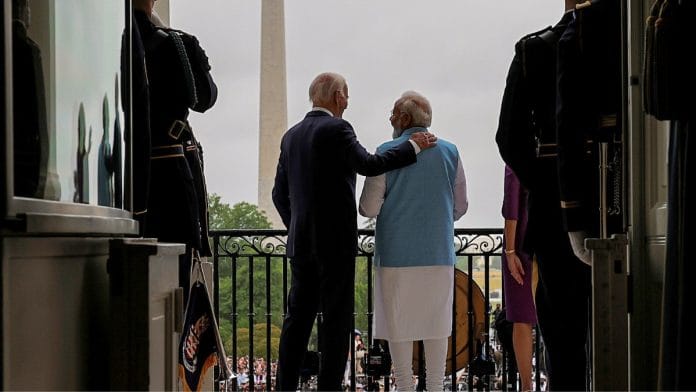New Delhi: From firming up a joint production plan for the jet engine to the assembly of MQ9B High Altitude Long Endurance (HALE) drones in India to Artemis Accord – that allows joint safe exploration of Moon and Mars – Prime Minister Narendra Modi’s State visit to the US has wrapped up a number of key projects.
The other key agreements and announcement included leading American technology firm Micron Technology investing up to USD 825 million to build a new semiconductor assembly and test facility in India with support from the Indian government.
Prime Minister Modi and US President Joe Biden also launched two Joint Task Forces on advanced telecommunications, focused on Open RAN and research and development in 5G/6G technologies.
Public-private cooperation between vendors and operators will be led by India’s Bharat 6G Alliance and the US Next G Alliance, a joint statement released by the two countries said.
Another big development is the partnership in the field of quantum computing. The two countries have established a joint Indo-US Quantum Coordination Mechanism to facilitate collaboration among industry, academia, and government which will eventually work towards a comprehensive Quantum Information Science and Technology agreement.
Also read: India & US are walking shoulder-to-shoulder in every field, says Modi in Oval Office
Big strides in defence partnership
The key developments from PM Modi’s trip to the US came in the defence sector. As reported by ThePrint, in what is being termed as beginning of a new era of the India-US partnership, American firm General Electric and India’s state-run Hindustan Aeronautics Limited (HAL) have signed an MoU to jointly produce fighter jet engines for the Indian Air Force (IAF) with “significant amount of transfer of technology and work being done indigenously”.
The deal could eventually end India’s quest since the 1960s to manufacture its own jet engine. While a number of countries, including India, make their own fighter aircraft, the technology of engine manufacturing has been aced by only a select few.
The joint statement referred to the jet engine deal as “landmark” and “trailblazing initiative” that will enable greater transfer of US jet engine technology than ever before.
Another key development was the plan for India to procure 31 HALE drones, MQ-9B, from the US to beef up surveillance and attack capability of the Indian Navy, Army and the IAF.
The joint statement said MQ-9Bs will be assembled in India and will enhance the ISR (intelligence, surveillance and reconnaissance) capabilities of India’s armed forces.
As part of this plan, General Atomics will also establish a Comprehensive Global MRO (Maintenance, Repair and Overhaul) facility in India to support its long-term goals to boost indigenous defence capabilities.
The American firm has a tie-up with India’s Bharat Forge, part of the Kalyani Group, for its drone business.
As reported by ThePrint, the Navy will get 15 MQ-9B drones in maritime and anti-submarine warfare kits, while the Army and the IAF will get eight each of the land version.
While both the variants have the option of being armed, sources in the defence and security establishment said initially, all the drones will be unarmed.
During Modi’s visit, both countries also set up and launched the US-India Defense Acceleration Ecosystem (INDUS-X). As a network of universities, startups, industry and think tanks, INDUS-X will facilitate joint defence technology innovation, and co-production of advanced defence technology between the respective industries of the two countries.
The US Department of Defense’s Space Force has signed its first International Cooperative Research and Development Agreement with Indian start-ups 114 AI and 3rdiTech. Both companies will work with General Atomics to co-develop components using cutting edge technologies in AI and semiconductors respectively, the joint statement said.
Joint forays into space
The joint statement said that both leaders “set a course to reach new frontiers across all sectors of space cooperation”.
National Aeronautics and Space Administration (NASA) and Indian Space Research Organisation (ISRO) will now work to develop a strategic framework for human spaceflight cooperation by the end of 2023.
India also signed the Artemis Accords which advance a common vision of space exploration for the benefit of all humankind. The Artemis Accords were established by NASA in 2020, in coordination with the US Department of State and seven other founding member countries.
As a part of the programme, NASA plans to land the first woman and the first person of colour on the Moon, make new scientific discoveries and explore more of the lunar surface than before.
Ukraine and global security
The two leaders expressed their deep concern over the conflict in Ukraine and mourned its tragic humanitarian consequences.
They underscored the impacts of the war on the global economic system, including on food, fuel and energy security, and critical supply chains, and called for greater efforts to mitigate them.
Both countries further pledged to continue rendering humanitarian assistance to the people of Ukraine. They also recommitted themselves to empowering the Quad as a partnership for global good.
They reiterated their commitment to a free, open, inclusive, peaceful, and prosperous India-Pacific region with respect for territorial integrity and sovereignty, and international law.
Both sides emphasised the importance of adherence to international law, particularly as reflected in the United Nations Convention on the Law of the Sea (UNCLOS), and the maintenance of freedom of navigation and overflight, in addressing challenges to the maritime rules-based order, including in the East and South China Seas.
(Edited by Smriti Sinha)
Also read: India-US trade ties deepening, but Modi may need to commit to easing protectionist policies






